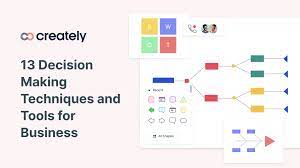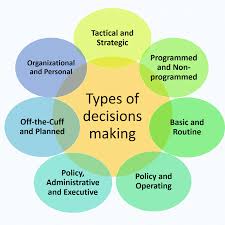Strategic Decision Making Tools: Enhancing Your Decision-Making Process
In today’s fast-paced and ever-changing business landscape, making strategic decisions is crucial for the success and growth of any organization. However, with so many variables and uncertainties to consider, decision-making can often feel overwhelming. This is where strategic decision-making tools come into play.
Strategic decision-making tools are frameworks or methodologies designed to support leaders in making well-informed and effective decisions. These tools provide structure, analysis, and clarity to the decision-making process, enabling organizations to navigate complex situations with confidence. Let’s explore some of the most commonly used strategic decision-making tools:
- SWOT Analysis: SWOT stands for Strengths, Weaknesses, Opportunities, and Threats. This tool helps organizations assess their internal strengths and weaknesses while identifying external opportunities and threats in their industry or market. By analyzing these factors, leaders can gain a comprehensive understanding of their organization’s position and make informed decisions accordingly.
- Decision Trees: Decision trees are visual representations of decision options and potential outcomes. They help break down complex decisions into smaller components, allowing leaders to evaluate different scenarios and their respective probabilities. Decision trees enable organizations to assess risks, rewards, costs, and benefits associated with each option before making a final choice.
- Cost-Benefit Analysis: Cost-benefit analysis involves weighing the costs of a decision against its potential benefits or returns. By quantifying both the monetary and non-monetary aspects of a decision, organizations can determine if the benefits outweigh the costs or vice versa. This tool helps prioritize options based on their overall value to the organization.
- Scenario Planning: Scenario planning involves creating multiple plausible future scenarios based on different assumptions or variables. It helps organizations anticipate potential challenges or opportunities that may arise in the future by considering various possibilities systematically. By exploring different scenarios in advance, leaders can develop contingency plans and make proactive decisions that align with their long-term goals.
- Decision Matrices: Decision matrices are grids that allow organizations to evaluate and compare different options based on multiple criteria or factors. By assigning weights to each criterion, decision matrices help quantify and rank the importance of various factors in the decision-making process. This tool provides a structured approach for objectively assessing options and selecting the most suitable one.
- Pareto Analysis: The Pareto principle states that roughly 80% of the effects come from 20% of the causes. Pareto analysis helps organizations identify and prioritize the most significant issues or factors influencing a decision. By focusing on the vital few rather than the trivial many, leaders can allocate resources effectively and make decisions that have a substantial impact on their organization’s success.
These strategic decision-making tools are just a few examples of the many frameworks available to support leaders in making informed choices. Each tool has its unique advantages and applications, depending on the nature of the decision at hand. By leveraging these tools, organizations can enhance their decision-making process, minimize risks, seize opportunities, and ultimately achieve their strategic objectives.
In conclusion, strategic decision-making tools provide valuable assistance in navigating complex business environments. They offer structure, analysis, and clarity to leaders who are faced with critical decisions that can shape their organization’s future. By incorporating these tools into their decision-making processes, organizations can make well-informed choices that drive success and growth in an increasingly competitive world.
Frequently Asked Questions: Strategic Decision-Making Tools and Strategies
- What are the five decision-making strategies?
- What are examples of decision-making tools?
- What are the 7 decision-making strategies?
- What are the 7 decision-making tools?
What are the five decision-making strategies?
There are various decision-making strategies that individuals and organizations can employ based on the specific circumstances and goals. Here are five commonly recognized decision-making strategies:
- Rational Decision Making: This strategy involves systematically evaluating all available options, gathering relevant information, and weighing the pros and cons before making a logical and objective decision. It aims to optimize outcomes by considering all factors and selecting the option with the highest expected value.
- Intuitive Decision Making: Intuitive decision making relies on gut feelings, instincts, and past experiences rather than extensive analysis or data. It involves trusting one’s intuition to make quick decisions in situations where time is limited or when there is a need for immediate action. This strategy is often used in high-pressure environments or when dealing with familiar situations.
- Incremental Decision Making: Incremental decision making involves making small adjustments or changes over time rather than pursuing radical or major shifts. It allows for flexibility and adaptability by gradually testing and implementing decisions while monitoring their impact. This strategy is useful when dealing with complex or uncertain situations where a step-by-step approach is preferred.
- Collaborative Decision Making: Collaborative decision making involves involving multiple stakeholders, such as team members, experts, or relevant parties, in the decision-making process. It promotes collective input, diverse perspectives, and consensus-building to ensure buy-in from all involved parties. This strategy fosters collaboration, encourages creativity, and increases the likelihood of successful implementation.
- Ethical Decision Making: Ethical decision making focuses on aligning choices with moral principles and values. It considers the potential ethical implications of decisions on individuals, communities, or society as a whole. This strategy emphasizes fairness, integrity, transparency, and social responsibility when evaluating options.
It’s important to note that these decision-making strategies are not mutually exclusive but can be combined or adapted based on the specific situation at hand. Effective decision makers often employ a combination of these strategies depending on factors such as time constraints, available information, complexity, and ethical considerations.
What are examples of decision-making tools?
There are various decision-making tools available to support individuals and organizations in making informed choices. Here are a few examples:
- Decision Trees: Decision trees help break down complex decisions into smaller components by visually representing decision options and potential outcomes. They enable a systematic evaluation of different scenarios and their respective probabilities.
- SWOT Analysis: SWOT (Strengths, Weaknesses, Opportunities, Threats) analysis helps assess an organization’s internal strengths and weaknesses while identifying external opportunities and threats. It provides a comprehensive understanding of the organization’s position and aids in strategic decision making.
- Cost-Benefit Analysis: Cost-benefit analysis involves weighing the costs of a decision against its potential benefits or returns. By quantifying both monetary and non-monetary aspects, organizations can determine if the benefits outweigh the costs or vice versa.
- Scenario Planning: Scenario planning involves creating multiple plausible future scenarios based on different assumptions or variables. It helps anticipate potential challenges or opportunities, enabling proactive decision making and contingency planning.
- Decision Matrices: Decision matrices are grids that allow for evaluating and comparing different options based on multiple criteria or factors. By assigning weights to each criterion, decision matrices help quantify and rank the importance of various factors in the decision-making process.
- Pareto Analysis: The Pareto principle states that roughly 80% of effects come from 20% of causes. Pareto analysis helps identify and prioritize the most significant issues or factors influencing a decision, allowing leaders to focus on what truly matters.
- Six Thinking Hats: Developed by Edward de Bono, this tool encourages parallel thinking by assigning different “hats” to participants, representing various perspectives (e.g., logical thinking, emotional thinking, creative thinking). It facilitates comprehensive exploration of a problem or decision from multiple angles.
- Force Field Analysis: Force field analysis examines the driving forces (factors that promote change) and restraining forces (factors that hinder change) related to a decision. It helps identify and evaluate the factors influencing the success or failure of a decision.
- Decision Support Systems: Decision support systems utilize technology and data analysis tools to provide insights, models, and simulations for decision making. They assist in analyzing complex data sets and generating recommendations based on predefined algorithms.
- Brainstorming: While not strictly a tool, brainstorming is a widely used technique to generate ideas and solutions through group collaboration. It encourages creative thinking, enabling diverse perspectives and innovative approaches to decision making.
These are just a few examples of decision-making tools available. The choice of tool depends on the nature of the decision, the available resources, and the specific requirements of the situation at hand.
What are the 7 decision-making strategies?
There are several decision-making strategies that individuals and organizations can employ to approach the decision-making process. While there are various models and frameworks available, here are seven commonly recognized decision-making strategies:
- Rational Decision Making: This strategy involves a systematic and logical approach to decision making, where individuals gather information, assess alternatives, evaluate risks, and select the option that maximizes utility or meets specific criteria.
- Intuitive Decision Making: Intuition-based decision making relies on gut feelings, instincts, and past experiences. It involves quick assessments of the situation without extensive analysis. This strategy is often used in situations where time is limited or when dealing with familiar scenarios.
- Incremental Decision Making: This strategy involves making small adjustments or changes to existing decisions based on feedback and experience. It allows for flexibility and adaptability as decisions are continuously refined over time.
- Normative Decision Making: Normative decision making focuses on adhering to established norms, rules, or ethical principles when making choices. It ensures decisions align with moral standards or social expectations.
- Satisficing: Satisficing refers to selecting the first acceptable option rather than seeking the optimal solution. This strategy is useful when faced with complex decisions or limited resources since it aims for a satisfactory outcome rather than an ideal one.
- Group Decision Making: Group decision making involves involving multiple individuals in the decision-making process to gain diverse perspectives and expertise. It can lead to better outcomes by considering different viewpoints and fostering collaboration.
- Autocratic Decision Making: In this strategy, a single individual makes decisions without seeking input from others. It is often used in situations requiring quick action or when a leader possesses specialized knowledge or expertise.
It’s important to note that these strategies are not mutually exclusive, and various factors such as time constraints, complexity of the problem, available information, organizational culture, and personal preferences can influence which strategy is employed in a particular situation.
By understanding and utilizing these decision-making strategies, individuals and organizations can approach decision making more effectively, considering different perspectives, optimizing outcomes, and aligning choices with their goals and values.
What are the 7 decision-making tools?
There are various decision-making tools that can be used depending on the context and nature of the decision. While there may be different frameworks and methodologies, here are seven commonly recognized decision-making tools:
- SWOT Analysis: SWOT stands for Strengths, Weaknesses, Opportunities, and Threats. It is a tool used to assess an organization’s internal strengths and weaknesses while identifying external opportunities and threats in its industry or market.
- Decision Trees: Decision trees are visual representations of decision options and potential outcomes. They help break down complex decisions into smaller components, allowing leaders to evaluate different scenarios and their respective probabilities.
- Cost-Benefit Analysis: Cost-benefit analysis involves weighing the costs of a decision against its potential benefits or returns. By quantifying both the monetary and non-monetary aspects of a decision, organizations can determine if the benefits outweigh the costs or vice versa.
- Scenario Planning: Scenario planning involves creating multiple plausible future scenarios based on different assumptions or variables. It helps organizations anticipate potential challenges or opportunities that may arise in the future by considering various possibilities systematically.
- Decision Matrices: Decision matrices are grids that allow organizations to evaluate and compare different options based on multiple criteria or factors. By assigning weights to each criterion, decision matrices help quantify and rank the importance of various factors in the decision-making process.
- Pareto Analysis: The Pareto principle states that roughly 80% of the effects come from 20% of the causes. Pareto analysis helps organizations identify and prioritize the most significant issues or factors influencing a decision.
- Six Thinking Hats: Developed by Edward de Bono, this tool encourages individuals to think from different perspectives represented by six “hats” – white (facts), red (emotions), black (caution/negative aspects), yellow (optimism/positive aspects), green (creativity), and blue (overview/control). It helps foster comprehensive and balanced thinking during decision-making processes.
These tools provide structure, analysis, and clarity to the decision-making process, enabling organizations to make informed choices and mitigate risks. However, it’s important to note that the selection of the appropriate tool depends on the specific context and requirements of each decision.




